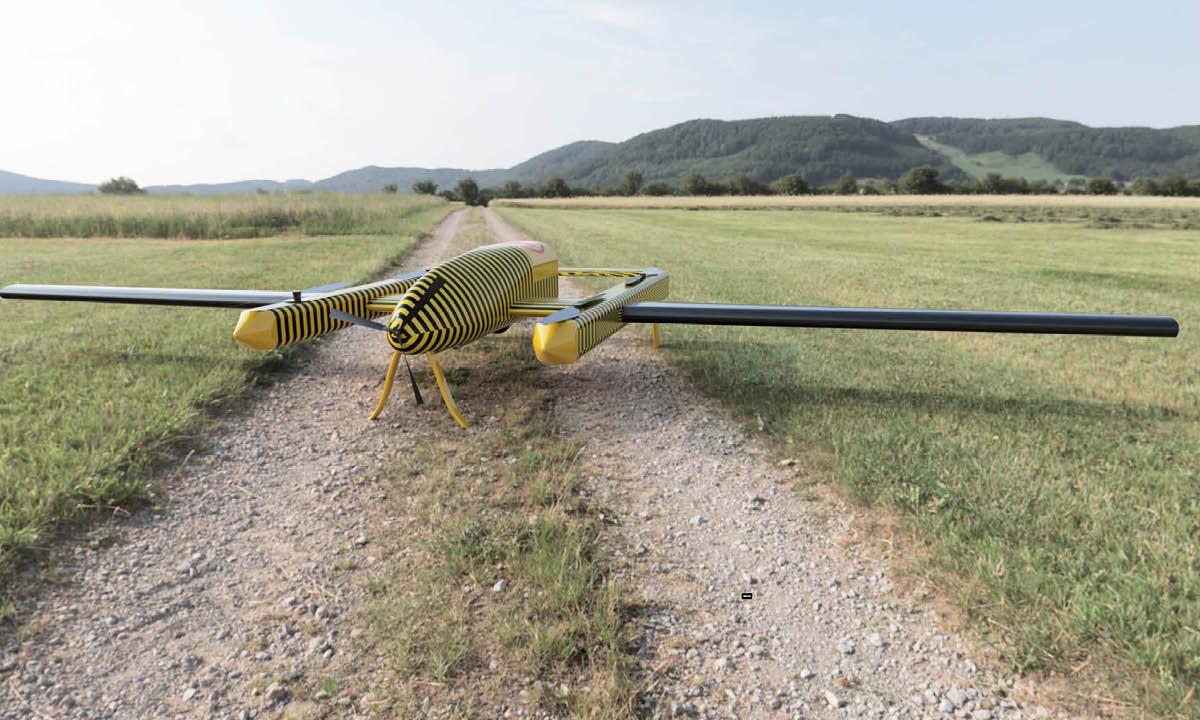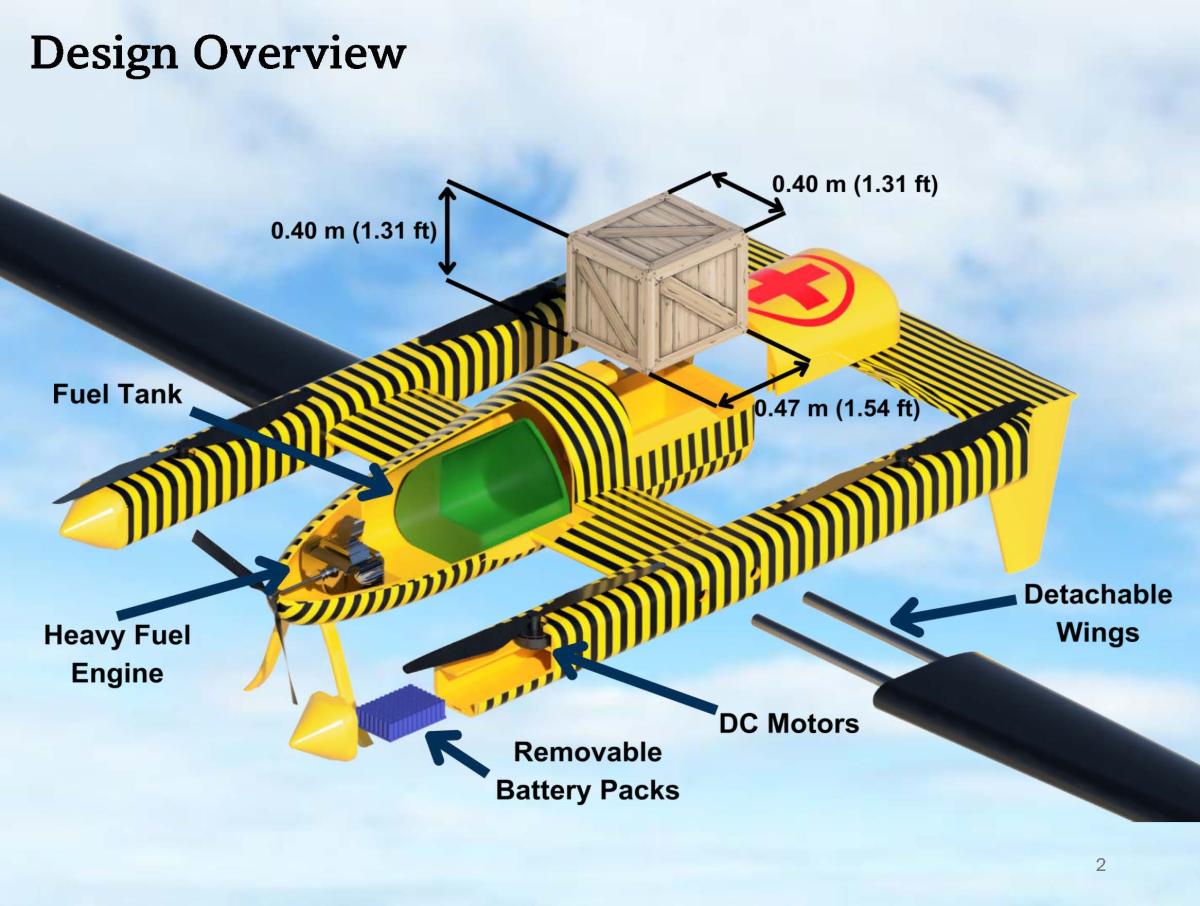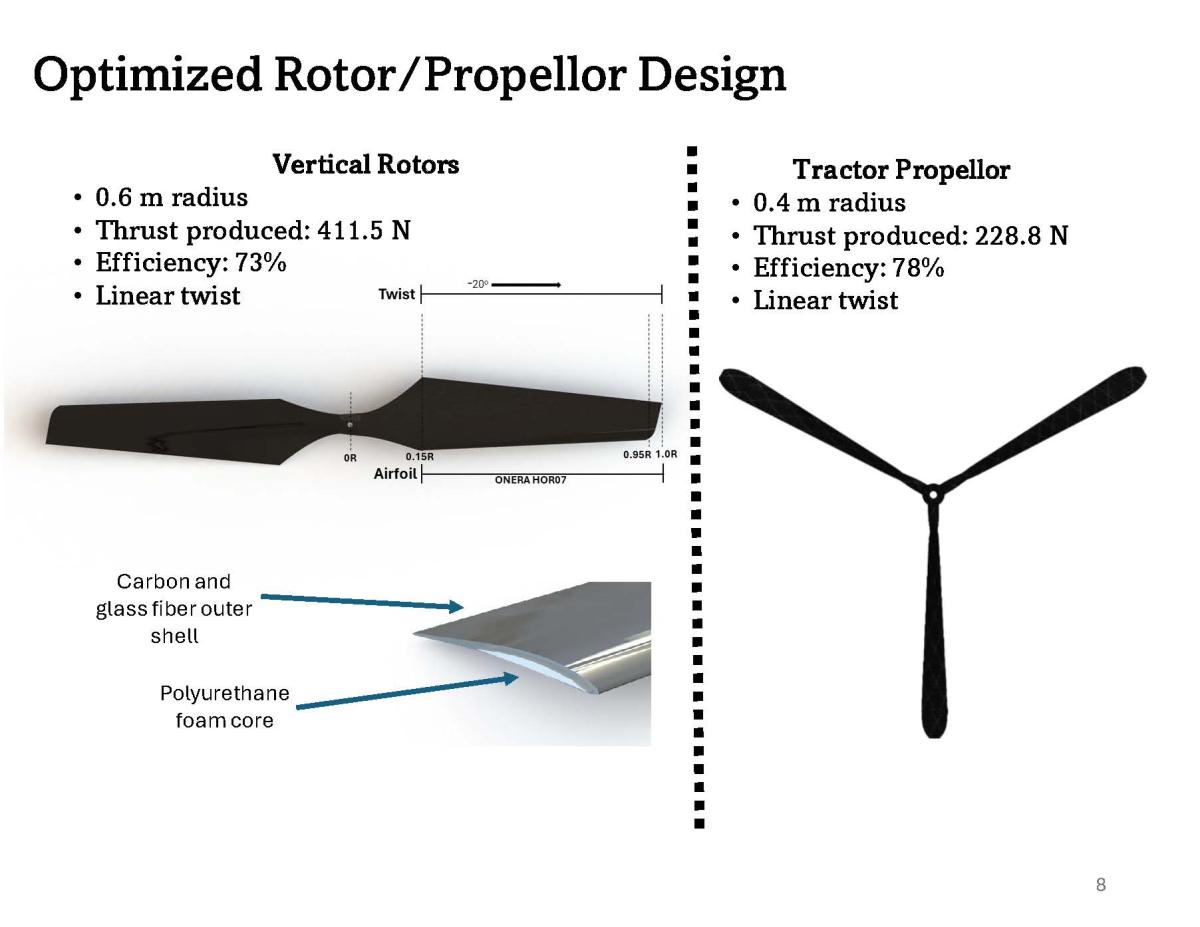Team AeroLay takes first place, and team Horus brings home second place.

AeroLay
Georgia Tech’s eight-person team, AeroLay, secured first place in the undergraduate category at the Vertical Flight Society’s (VFS) 41st Annual Student Design Competition (SDC), sponsored by DEVCOM Army Research Lab. Team Horus won second place in the graduate category.
The mission was to design a modular multi-mission vertical takeoff and landing (VTOL) that could take off and land vertically from the deck of a ship in high winds and gusty conditions, cruise to and from the site of a disaster, serve as a long-endurance communications relay, and land vertically to deliver relief supplies or take-off and landing an uncrewed aerial system (UAS).
“I am so very proud of the AeroLay team - with special congratulations to the two project leads - Tanner Zagrodnik and Aleksandr (Sasha) Lutsenko,” said Chance McColl, the team’s faculty advisor and AE School lecturer. “This was a collaboration across AE 4331 and AE 4332 - the latter taught by the excellent Sihong Yan, post-doctoral researcher, who also serves as the faculty co-advisor to the team. It was a privilege to be a part of this effort, watching the team grow in experience in rotary wing aeromechanics and design. Their design was innovative and well thought out - a reflection of the time, energy, and effort they devoted. Team - well done, and congratulations again!”
Two members of AeroLay will present their winning technical presentation at Forum 81, which will take place from May 20-22, 2025, in Virginia Beach, Virginia, during one of the Aircraft Design technical sessions. The two students will receive complimentary Forum 81 registration bringing the total award to $3,000.00.
From left to right: Mervyn Praveen, Irelyn Meckley, Kaitlyn Kosten, and Tanner Zagrodnik
From left to right: Kaitlyn Kosten, Irelyn Meckley, Cory Chianello, and Aidan Peairs
Team AeroLay to the Rescue
Team AeroLay worked long hours to secure the victory, overcoming design challenges associated with multiple mission requirements. Team members included Tanner Zagrodnik, team captain and propulsion lead; Aleksandr Lutsenko, aerodynamics lead; Cory Chianello, aerodynamics; Mervyn Praveen, structures lead; Kaitlyn Kosten, technical writing and operations; Irelyn Meckley propulsion; Aidan Peairs, controls; and Shalva Begiashvili, structures.
“We knew we were up against strong competition, and with last year’s Georgia Tech undergraduate team taking first place, we had high expectations to meet. So, we focused and got to work,” Zagrodnik said.
One of their first objectives was to design their aircraft to maximize the mass of the carried payload and maximize the loiter time so that it could spend more time in the communications relay state. The challenge was balancing competing design requirements.
“Designing for endurance is very different from designing for speed, and neither directly translates to optimal vertical lift performance or handling large payload mass. Achieving a balance between all these capabilities was a significant challenge, particularly with the strict size and weight constraints we faced,” Zagrodnik noted.
To overcome these hurdles, the team designed AeroLay, a hybrid VTOL system featuring an independent thrust configuration. This enabled both powerful vertical takeoffs and efficient forward flight. It combined the capabilities of an electric multirotor like a quadcopter powered by batteries with a high aspect ratio, fixed-wing driven by a single propeller with a heavy fuel engine. The initial iteration of the design came about in the fall of 2023, and they kept modifying and improving it throughout the spring semester.
“It was like merging a standard electric quadcopter with an efficient conventional airplane. This hybrid configuration enabled the aircraft to meet the demanding requirements of both the long endurance and supply missions,” Zagrodnik said.
Their rotorcraft Capstone Design course taught them to use tools like XFOIL and MATLAB and good old-fashioned math to prove that the aircraft would work. They brainstormed, did many iterations, and communicated constantly through the sub-teams.
“Ultimately, it was satisfying to know that the countless hours we worked paid off, and we could continue Georgia Tech’s legacy,” Zagrodnik shared.

AeroLay Design

AeroLay Rotor
Hope, Healing, and Aid from Team Horus
For the graduate team, the base mission also required a video of the vehicle resisting 15 m/s wind gusts. They had to write out the full control laws of the vehicle. Up for the challenge, they built their aircraft with what they called modular pods. These pods could be swapped out in between missions, with one piece set to hold extra fuel tanks and the other designed to keep supplies.
“With this specific design competition, in both undergraduate and graduate categories, a lot of hard teamwork goes into it. So, it comes down to the full team pulling their weight and the team captain coordinating efforts,” said team co-faculty advisor and AE professor Juergen Rauleder. “As faculty advisors, we rather facilitate and guide the design process without trying to ‘force’ the decisions towards a certain design. Because, at the end of the day, it is a student design and not a faculty design. Therefore, the students deserve full credit for their winning entries! Congratulations! Hard work pays off!”
The ten-member team, Saisruthi Bandla, Heather Beers, Dante' Evangelista, Sai Vishal Gali, Zahra Mehtar, Ifeoluwa Oloworaran, Bryan Regan, Carla Sheridan, Gray Simmons, and Savanna Scott, team captain, competed in the graduate category.
“One of the most challenging aspects of this competition was to come up with a solution that was not only creative but functional as well. To do this, the team devised many innovative ideas, such as adding wings to help with the loitering mission and including a dual-purpose swivel tail. The swivel tail acted as yaw control during axial flight and as a pusher prop during forward flight,” said Scott, who earned her master’s degree from Georgia Tech last spring.
They divided the work into aerodynamics for the wing, aerodynamics for the rotor, controls, structures, and propulsion based on each team member's expertise.
Scott learned a real lesson in managing not only her time but also time for the entire team. Building the timeline for the team proved challenging, but working together, they overcame many hurdles. She credited Professor Marilyn Smith, who also serves as a faculty advisor for the graduate team, with giving them a competitive edge.
“In Dr. Smith’s class the semester before, she helped us understand how to go from a request for proposal (RFP) to a final product. She talked us through the steps to take, the order in the flow, and the overall process, and we were able to use those lessons for this RFP,” Scott shared.
“I’m very proud of the design the team came up with in the end,” Scott said, “and I appreciate all the hard work and effort everyone put into this project.”
Related Stories

Georgia Tech Lands on Top at the Vertical Flight Society’s Annual Student Design Competition
A team of Georgia Tech and the United States Military Academy at West Point (West Point) students won first place, and a Georgia Tech and Sapienza University team placed second in the Vertical Flight Society’s (VFS) 40th Annual Student Design Competition (SDC) sponsored by Sikorsky, a Lockheed Martin Company.

The Ramblin’ Rocket Club Swarms the Desert for Annual Rocket Launch
One early Saturday morning in July, 62 Georgia Tech students, alumni, and the Ramblin’ Rocket Club (RRC) sponsors, stood shoulder to shoulder in underground bunkers as they counted down from 10, awaiting the “go for launch” call.
(text and background only visible when logged in)